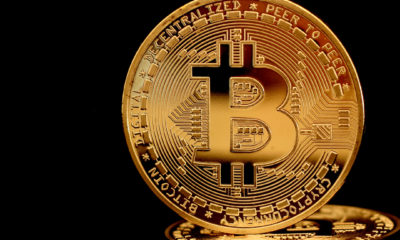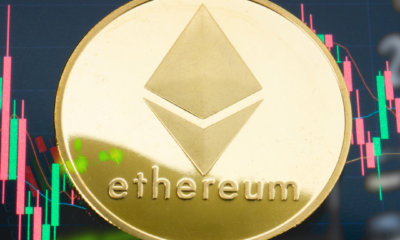Crypto News
Crypto’s Great Reset
Published
3 years agoon
By
admin
Five resets have defined Crypto’s history. The first was in 2014, when Mt. Gox, the world’s essentially only bitcoin exchange, fell after a roughly half-billion-dollar attack. The DAO Hack, which occurred in 2016, involved an attacker tricking a smart contract into giving away $60 million worth of Ethereum, which is now worth $8 billion. The third came in January 2018, when the ICO bubble burst, triggering a year-long slide that saw the crypto market lose 60% of its value, or $700 million, primarily in the form of worthless garbage tokens. The fourth occurred in March 2020, when crypto, like most other global financial markets, lost 40% of its value.
Each reset not only increased price-market capitalization but also made room for quick development. Coinbase and Kraken, the two largest exchanges in the United States, sprung from the ashes of Mt. Gox’s collapse because their CEOs saw that users needed safe venues to acquire bitcoin. The implosion of the DAO and the ICO crash laid the framework for today’s expansion of DeFi and the popularity of DAOs.
Last week, the fifth reset began. It has the potential to be the most significant yet. The trillion-dollar market crash this time was triggered by a sharp selloff in risky assets and the abrupt disappearance of LUNA, a $40 billion digital token that backed the $16 billion stablecoin TerraUSD (UST). Unlike the free-floating Luna tokens, each UST was created to be valued at exactly one dollar. The stablecoin lost its peg due to a perfect storm of greed and inadequate technology, and around $56 billion was lost between May 7 and May 12.
At its most basic level, the most recent crypto collapse is another reminder of how get-rich-quick schemes can overwhelm common sense. The loss of so much capital is forcing the industry to reckon with the entire concept of leverage in cryptocurrency markets, forcing it to be honest with itself as to whether innovation is just dressed-up leverage and could be the death knell for an entire category of asset, called algorithmic stablecoins. Dramatic bear market crashes have become all too regular in the embryonic cryptocurrency market. Consider that the US stock market has only had five bear markets in the last century, with stocks falling by more than 30%.
“Leverage can never make a bad investment good, but it can, and often does, make a good investment bad,” argues Mark Yusko, founder of Morgan Creek, an institutional and family investment advising firm. “And so that’s what we’re seeing in the past couple of months, particularly in the past week, just an unwinding of ridiculous levels of leverage. And in the case of the Terra problem from this past week—the Luna problem—it’s just a bad idea, bad structure. You can’t collateralize an asset, that’s supposed to be stable, with an unstable asset.”
The Terra Foundation, based in South Korea, attempted to address this by developing an algorithm that would replace many of the procedures that keep the US dollar stable. When the price falls, an arbitrage opportunity to swap a UST token worth less than a dollar for one dollar of Luna arises. Theoretically.
To put things in perspective, the Great Recession of 2008 was sparked by a housing bubble in which subprime loans were packaged and offered as fresh securities with perfect ratings. Their failure resulted in a loss of market confidence and a domino effect on financial institutions, resulting in potential exposure losses. Similarly, until its demise, stablecoin TerraUSD was supposed to be impregnable. According to Caitlin Long, a former Morgan Stanley managing director who is now building Custodia, a Wyoming-based crypto bank designed from the ground up to make money without leverage, losses were amplified because it was backed by software few understood but piled into because it promised quick riches. So much of what was cloaked as innovation was in fact leverage dressed up as something else,” she explains.
Lightspeed, a Menlo Park-based venture firm with $10 billion in assets under management, and one of Terra’s most prominent investors. Lightspeed is also one of the first venture capital firms to back the cryptocurrency, having invested in Ripple in 2013 and recently increasing their entire crypto holdings to $600 million. A firm spokeswoman sounded defiant when asked about the impact of what will undoubtedly be one of their most infamous investments. “We see this as a computing paradigm shift that is bigger than the ebb and flow of the short-term price of Bitcoin,” the representative explained. “We are doubling down, specifically in infrastructure, DeFi, and emerging use cases.”
Su Zhu, of Three Arrows Capital, another major supporter, remarked on Twitter that LUNA’s failure was due to its execution rather than its basic value proposition. On his Twitter profile, Zhu continues to proudly flaunt the #LUNA hashtag. At the very least, unlike Galaxy Digital founder Mike Novogratz, another major donor, Zhu did not have a Luna tattoo on his arm. He hasn’t said what he wants to do with the ink yet.
The reality is that, while greed played a role in Luna’s demise, its inception was motivated by a wish to preserve crypto’s decentralized ethos, which the burgeoning stablecoin industry had been forsaking. Tether and USD Coin, are the two largest stablecoins by market capitalization, with a combined market capitalization of $126 billion. While they operate on blockchains, they are managed by highly centralized organizations that have been notoriously opaque about the assets used to back their digital currencies. Tether has sparked controversy since it invests 40% of its assets on commercial paper from unknown sources.
Tether was, however, one of the numerous competitors who appeared to benefit from Terra’s demise. In the days following the crash, MKR, the cryptocurrency that underpins the DAI stablecoin, rose 38 percent, and while Tether briefly lost its peg, it swiftly regained its footing, reverting to its role as a relatively safe haven. “In the middle of last week, investors were rotating out of Tether to USDC for all their stablecoin needs,” says Raghu Yarlagadda, CEO of FalconX. “USDC was being bought at 2.5 times the normal rate. Toward the end of the week, what was very interesting was people were rotating out of USDC into fiat.”
Dante Disparte, the chief strategy officer at Circle, was perhaps the most disappointed rival, claiming that Luna’s demise reflected poorly on the entire stablecoin sector, referring to the UST as a “stable-in-name-only” token. Terra creator Do Kwon’s use of more than $3 billion in crypto collateral, he argued, exposed the enterprise as a centralized corporation operating under a decentralized flag.
“The behavior of Terra and its meltdown really, really, really flew in the face of the argument that Terra was totally decentralized because it took a handful of people and a handful of promissory statements on Twitter to either unravel it or to try to save it,” adds Disparte. “And that feels not only centralized, it feels capricious and arbitrary.”
The fact that Luna creator Do Kwon went out of his way to smear competitors didn’t help matters. In March, he stated that watching projects fail was “entertaining,” and that UST would destroy Dai, a similarly built stablecoin established in 2014.
Others, including Yusko and crypto expert Yassine Elmandjra, believe algorithmic stablecoins will never thrive. While most previous crypto resets were caused by technology difficulties that were later resolved and applied by other developers, it appears that the solution, in this case, is already in place: fiat-backed stablecoins. “It’s probably a very humbling realization for a lot of the institutional investors and influencers who were pounding the drum on some of the more experimental initiatives that were going on in crypto,” Elmandjra says. “I think the whole concept of algorithmic stable coins as being a promising project can be put to bed.”
How the market reacts to this abrupt shock will determine how quickly and how these questions are answered. Over the last six months, cryptocurrency has lost more than $1 trillion in value, with bitcoin falling from almost $70,000 to below $30,000. The fact that this could be the first macro crypto bear market in which institutions like Tesla have the asset on their balance sheets adds to the urgency. MicroStrategy, the world’s largest corporate bitcoin holder, is suddenly losing money for the first time ever, with a stockpile of 129,000 tokens at an average purchase price of $30,700.
The good news is that most investors don’t appear to be panicked, which should help to cushion the market’s fall. Ironically, this could be because investors had already begun to withdraw funds when Luna and Terra plummeted. According to Nikolaos Panigirtzoglou, managing director of global markets strategy at JPMorgan Chase, the industry saw “some de-risking in the crypto area even before Terra’s collapse.” “Bitcoin’s mean reversion began in October,” implying that investors began to reduce their crypto investments in late 2021. The direction of these flows will be a good indicator of investor mood in the future.
Another encouraging piece of crypto news is the popular expectation that the Luna/UST meltdown will not propagate throughout the crypto community or into the traditional financial world. Last week, the industry was put to the test when Tether lost its peg on Wednesday morning, plummeting below 95 cents before swiftly recovering. Tether was being shorted by investors in a deliberate attempt to drive the price down, according to Yarlagadda’s clients, though such accusations were unverified. If Tether loses its peg, it will be disastrous for the crypto business, with potential spillovers into traditional banking.
It would be great if this drama acted as a cautionary tale about excess in the crypto business, leading to more responsible forms of innovation. The unique financial institutions being built in Wyoming, where Caitlin Long’s Custodia is one of several would-be banks attempting to bring responsible forms of financing by refusing rehypothecation of assets—that is, collocating deposits and lending them to debtors—would be one test case. She’s even considering creating her own stablecoin.
There’s also been an expansion in the DeFi market, which has been accused of being little more than Ponzi schemes for years. It is attempting to become more business-friendly. AAVE and Compound, two leading platforms, have both developed institutional-only versions, with Compound’s service receiving a B- grade from Standard & Poor’s. That isn’t exactly investment-grade, and the protocol itself only has approximately $150 million under management, but it’s a start.
Crypto News
Is Crypto A Good Investment Opportunity Now?
Published
3 years agoon
September 7, 2022By
admin
Every big technological advancement has also brought with it great financial rewards for those who made shrewd investments. As television and radio technology improved in the 1960s, people who made the decision to invest in the companies that provided the technology were empowered with financial stability and moved closer to financial independence. Today’s consumers are still familiar with companies like IBM, Microsoft, and General Electric that once offered technology that the general public could purchase.
A tiny investment made in any of those companies at the time of their founding, when they released their most significant inventions at the time, has flooded those investors with incredible returns. You might have easily gotten back multiples of 1,000 with a minimal investment.
Since smartphones were first introduced, investments in smartphone inventions and innovators have all grown significantly.
When the general public could access the internet. A little Yahoo investment felt like a lotto win.
I use such scenarios as illustrations so you can see the possibilities that bitcoin investments present you with right now. The blockchain will continue to exist. We can easily understand that it would be a mistake to do nothing when technical marvels are unveiled to the general audience.
You need a device to store cryptocurrencies of any kind in order to own them. A “Wallet” is the name of that gadget. Without one, you cannot engage in cryptocurrency. Hardware wallets are a great option for portable media storage because they stand alone. The most secure way to store your cryptocurrency is in a hardware wallet. Whether you’re a professional investor or just a hardworking individual looking to advance, For this kind of investment, a bitcoin wallet is required.
A cryptocurrency wallet is an electronic, encryptable media storage device that is specific to its owner. A software wallet on the internet, sometimes known as a hot wallet, a hardware wallet, or a cryptocurrency exchange are all places where cryptocurrencies can be kept.
The risks of hacks are presented to the cryptocurrency owner (YOU) when storing cryptocurrency on a cryptocurrency exchange. Large sums of cryptocurrencies have disappeared from other investors as a result of hacks. So it would be foolish to assume that you won’t be the next victim. If your account is hacked, the damage can be beyond repair. We strongly advise moving your cryptocurrency coins—as well as any money made from selling them—to your private hardware wallet. After making a purchase or sale on a cryptocurrency exchange, this action should be taken.
Hot wallets are not completely safe because they connect to the internet through browser software.
A excellent illustration would be to contrast a hot wallet with a man’s pocket-carried wallet. The man can make quick purchases since he always has his wallet on him. Even though the man’s wallet is securely tucked away in his pocket whenever he goes out in public, pickpockets and thieves are constantly looking for opportunities to steal his money.
Due of their adaptability, multi-currency wallets that support ERC20 (NFTs) are advised.
Hardware wallets from TREZOR and KeepKey continue to receive positive evaluations. All of the information about these two manufacturers of cryptocurrency wallets is excellent. They are two of the leading producers of these products in the market.
Another top producer of hardware wallets is Ledger. A well-liked brand and design is the Ledger Nano S Plus. After avoiding a security breach, this model and its manufacturer are now even more resilient. For significant amounts of investing capital, getting a wallet and a backup wallet is necessary.
Here, we need to pause for a moment. Some sovereign states forbid their citizens from owning or conducting transactions in certain cryptocurrencies. Some countries forbid its residents from engaging in any cryptocurrency activity. Please do your own research and familiarize yourself with the laws that are relevant to you.
A list of 9,590 cryptocurrencies that may be bought and sold was found by me. Since seeing that listing, I have seen announcements of the creation of new cryptocurrencies every day. With so many investing possibilities, it’s important to have solid knowledge of the most valuable cryptocurrencies.
Out of the 9,950 cryptocurrencies I discovered, the top 30 had market capitalizations ranging from $85,860,000 to a mind-blowing high of $39,988,647,800 for Bitcoin. The top 15 cryptocurrencies at the time of my writing will be our main emphasis.
Bitcoin
Ethereum
Ripple
USD Coin
BNB
Binance USD
Solana
Cardano
Dogecoin
Tether
TRON
Polkadot
Polygon
Dai
Shiba Inu
Speculative investing on the cryptocurrencies with a lesser market value can be taken into consideration as you continue to educate yourself about cryptocurrencies.
Let’s reduce the number of cryptocurrencies on the list to the top 10. I am unable to personally advise you on what cryptocurrency to purchase or how much money to invest. However I can offer you some advice that could be really useful. The amount of money that is regarded as a benchmark for financial investments is $10,000 US dollars. The number 10,000 or a multiple thereof works very well with the math involved in calculating gains and limiting losses in the financial sector. It is also a wonderful number to utilize in order to demonstrate yields, percent of change, and growth rates.
The bitcoin market has demonstrated erratic behavior in both positive and negative directions. Furthermore, the newly available option to sell some of these financial instruments short leads to an enormous number of possible strategy combinations. Here is a quick and efficient way to start your cryptocurrency investment plan.
Think about it, You might only be able to purchase 1 whole bitcoin with $10,000. Or perhaps you can only purchase 5 whole Ethereum coins. If the value of Bitcoin increases by $100, you will only have made a $100 profit on an investment that may have cost $20,000 or more, not including any additional expenses. That is less than 1% return on your hefty investment. You may possibly earn $1,000 to $2,000 or more from an investment that cost you roughly $10,000 after fees if Ethereum increases in value, which it has. That represents a 10%–20% return on your investment. Using this straightforward comparison, I’ll show you how having more coins enables you to take advantage of price fluctuations that are favorable to you more effectively.
Fortunately for us, cryptocurrency can be purchased and sold in increments up to and including the tenth place after the decimal point. You can then distribute your $10,000 evenly across the top ten cryptocurrencies. A portfolio of cryptocurrencies that is well-balanced enough to reap the full potential of gains from their movements might be created by allocating $1000 to each of the top 10 cryptocurrencies.
Where can I purchase cryptocurrency?
Similar to how corporate stocks are purchased and sold on stock exchanges, cryptocurrencies are bought and sold on cryptocurrency exchanges. The top exchanges for cryptocurrencies are:
Binance
Coinbase
Crypto.com
Kraken
Bitstamp
Bitfinex
LocalBitcoins (peer to peer)
Coinmama
CEX.IO
itBit
Changelly
With one of the friendliest user interfaces, Coinbase is accessible to people everywhere. Peer-to-peer exchanges are more expensive to use but provide greater transaction privacy. In order to invest in cryptocurrencies, opening an account is a simple but time-consuming process.
Now that you have given yourself the tools, you can trade cryptocurrencies. The earliest possible moment to participate is now. Anyone who claims to have entered a market at the bottom and made a profitable sale at the top is almost always lying. Even while they did make profitable trades, the majority of professionals will acknowledge that they missed the bottom and top of trading markets. You cannot benefit until you participate, that much is certain. Cryptocurrencies should be viewed as high-risk venture capital investments with the potential for incredible profits. Protect your prospective gains, and in turn, reduce your possible losses.
Read More Cryptocurrency News Here
Crypto News
Crypto Is A Great Hedge Against Turkish Inflation And The Lira
Published
3 years agoon
September 7, 2022By
admin
Despite the conflict in the Ukraine, for people in Turkey and many around the world, 2022 will most certainly be remembered as the year of inflation. Prices have increased by about 9% in both the United States and the European Union after decades of inflation below 5%, with supply shocks to the energy and food industries accounting for the majority of the increase (not to mention quantitative easing).
However, 9% is still not as awful as the inflation wrecking havoc on the Turkish economy, which has enjoyed years of 2% inflation or below. Year-over-year inflation in Turkey is now officially estimated to be at 80%, but unofficial data suggests real inflation may have reached 140% as early as April.
Such staggering numbers have had a significant negative impact on Turkish citizens, but many have discovered a rather creative way to mitigate the effects of inflation: cryptocurrencies. Although Turkey has a reputation for being an authoritarian state, despite having one of the highest percentages of cryptocurrency ownership globally, the country shows that bitcoin is used for more than simply high-risk speculation.
August saw an increase in the official consumer price index for Turkey of 80.2% over the previous month, which was already very high. This marks both the highest rate ever observed during President Recep Tayyip Erdoan’s almost 20-year leadership and the first time official inflation has exceeded 80% since 1998.
In Turkey, where Erdoan refused to raise interest rates to a level that may potentially restrain price increases, lax monetary policy is usually held responsible for the country’s out-of-control inflation. Despite this, the government predicts that inflation will start to decline by the year’s end.
The nation’s finance minister, Nureddin Nebati, predicted on Twitter that inflation would slow down much further in the coming months. “We shall expel high inflation from these countries, and it will never come back.”
Whatever the future holds, regular Turks are now feeling the effects of inflation, which has been happening for a while. Its data on cryptocurrency ownership makes this clear; according to Statista’s figures, 20% of the population owned or had held cryptocurrencies in 2019, and that number increased to 25% in 2021.
Data on worldwide cryptocurrency ownership is fascinating since it shows that countries with similar stresses to Turkey typically have the largest levels of such ownership. To put it another way, individuals turn to bitcoin and other cryptocurrencies as a way to preserve (or grow) whatever meager wealth they already have as a result of inflation.
As a result, Turkey boasts one of the most active cryptocurrency markets globally, despite recent attempts by the government to limit it in various ways (so far unsuccessfully).
In December 2021, data from Chainalysis and Kaiko showed that the country’s borders were clocking in at almost one million cryptocurrency transactions per day. This may have been one of the clearest indications of how busy the Turkish crypto industry is.
What Comes Next for Turkey and Cryptocurrency
People on the ground corroborate that they bought bitcoin and other cryptocurrencies in response to the problems facing the Turkish currency.
According to Izzet Emre Ari, a twenty-something computer engineer who talked to Reuters in 2021, “If my savings are in lira, they are losing value.”
Turkish cryptocurrency trading has gained so much traction that some local commentators have spoken of a “cryptolization” process as the local population switches to cryptocurrencies as a way of asset preservation.
According to Turan Sert, an adviser to the Paribu exchange in Turkey, who talked to Al Jazeera in January, “in the past it was dollarization, meaning in order to prevent swings in their currency individuals held their assets in dollars.” The most current fad is now referred to as cryptolization.
Even more recently, industry insiders in Turkey claim that the bear market of 2022 hasn’t significantly diminished Turkish enthusiasm for cryptocurrencies. This is due to the Turkish lira falling even more sharply than Bitcoin, which has declined by 71% since hitting an all-time high of USD 69,000 in November.
Because we want to protect our money from rising inflation and high interest rates, there is a huge demand for and trading volume in Turkey’s cryptocurrency market. According to author and consultant Vedat Guven, who was recently interviewed by German state-run news outlet DW, there are 5.5–6 million Turks who have cryptocurrency accounts, and if you include family members, 10–12 million individuals are interested in this.
Read More Cryptocurrency News Here
Crypto News
Crypto.com Sues Australian Woman After Giving $7.1 Million Instead Of $68
Published
3 years agoon
September 6, 2022By
admin
It took Crypto.com seven months to recognize that it had transferred a woman in Australia AU$10.5 million dollars (about $7.1 million at the current conversion rate), rather than the 100 Australian dollars that the woman had sought as a refund. Now, the cryptocurrency trading platform is going after Thevamanogari Manivel, who resides in Melbourne, as well as her sister, Thilagavathy Gangadory, in an effort to retrieve its money — along with ten percent interest and the costs of legal representation.
According to the records presented in court, in May of 2021, a worker for the trading platform situated in Singapore made the error of entering an account number into the field for the payment amount. When Crypto.com was carrying out a standard audit in December 2021, it was then that the company learned it had sent Manivel millions of dollars in error.
According to the petition, Manivel invested around AU$1.35 million of the unexpected windfall in the purchase of a property.
Even though bitcoin transactions cannot be undone, it is theoretically possible for centralized platforms to undo payments made using cryptocurrencies in the event of fraud or error. However, in this particular instance, the mistake was not uncovered by the corporation until seven months later, after some of the money had reportedly been transferred or spent. According to the petition, the corporation was successful in convincing the authorities in February to freeze Manivel’s bank account; however, the money had already been moved to other defendants mentioned in the case by the time the account was frozen.
The judge’s decision was favorable to Crypto.com, and the matter will be heard again in October before another judge who will decide the next measures to take in the proceeding.
The lawsuit was filed during a particularly challenging period for the platform. It has been reported that the company has gone through a second round of aggressive cuts, as crypto firms across the board look for ways to cut costs in response to investors rotating out of the riskiest assets, which is pulling down trading volumes. In June, the company let go of 260 employees, which represented 5% of its workforce.
Both bitcoin and ether have experienced losses of more than 58% so far in 2018, and the total value of the cryptocurrency market as a whole has dropped below $1 trillion, having peaked above $3 trillion in November 2021.
In the meantime, Crypto.com is responsible for some hefty ongoing payments, including a multiyear naming rights deal with the Staples Center in Los Angeles, which is the home of the Lakers and the Sparks of the WNBA. The deal is worth a total of $700 million.
In a recent report, Crypto.com stated that the company was unable to comment on the topic “since the matter is before the courts.”
Read More Cryptocurrency News Here














You must be logged in to post a comment Login